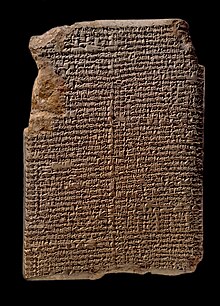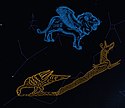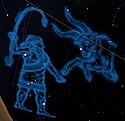MULAPIN

MUL.APIN (𒀯𒀳) ist die übliche Bezeichnung für ein babylonisches Kompendium, das sich mit vielen verschiedenen Aspekten der mathematischen babylonischen Astronomie befasst. Jüngste Edition ist die von Hunger und Steele (2018).[1] Möglicherweise steht es bzw. Teile davon in der Tradition früherer Sternkataloge, der so genannten Three-Stars-Each-Listen. Allerdings geht dieses Kompendium weit darüber hinaus. Es besteht aus zwei großen Teilen: Im ersten Teil wird die scheinbare Himmelskugel beschrieben, also die Daten zum Bau eines Globuskalenders[2] gegeben, im zweiten Teil geht es um Zeitrechnung mit Hilfe dieses Sternkalenders sowie mit Sonnen- und Wasseruhren. Den Abschluss bildet eine Liste von Omina. Die Daten beruhen auf genaueren Beobachtungen verschiedenen Alters:[3] Manche der Teil-Listen datieren zwischen 1400 und 1100, manche anderen sind möglicherweise jünger oder älter. Die Kompilation datiert wahrscheinlich zwischen 1250 und 1000 v. Chr. Der Text listet die Namen von über 70 Sternen und Sternbildern auf und enthält darüber hinaus eine Reihe von Angaben wie Auf-, Untergangs- und Kulminationsdaten, die dazu beitragen, die Grundstruktur der babylonischen Sternkarte darzustellen.
Das älteste Exemplar datiert ins 7. Jahrhundert v. Chr., ist auf zwei Tafeln erhalten, die nach ihrem Incipit benannt sind und dem ersten Sternbild des Jahres, MULAPIN, "Der Pflug", entsprechen, das nach der Zusammenstellung der Vorschläge von Gössmann[4] und Kurtik[5] mit Sternen im Bereich der modernen Sternbilder Kassiopeia, Andromeda und Triangulum identifiziert wird. Neuerdings wird vorgeschlagen, dass es nur die hellen Kassiopeia-Sterne sind.[6]
Datierung
Der Astrophysiker Bradley Schaefer und der Astronom Teije de Jong haben errechnet, dass die Daten der heliakischen Auf- und Untergänge in diesen Tafeln in die Region von Assur um das Jahr 1370±100 v. Chr. (Schaefer)[7][8] bzw. ungefähr in die Epoche zwischen 1400 und 1100 v. Chr. (de Jong[9]) passen.
Watson und Horowitz[3] haben gezeigt, dass der Textstil von einer Liste zur anderen von geringer zu hoher Komplexität wechselt. Daher ist es gut möglich, dass Liste 1 älter ist als Liste 2-4 und diese wiederum älter als Liste 5 usw.
Inhalt
Der Text wurde häufig auf zwei, mitunter auch auf drei Tafeln geschrieben. Egal, wie viele Tafeln er physisch einnimmt, besteht er aus zwei inhaltlichen Teilen:
| Liste 1 | I i 1 | to | I ii 35 | Katalog der Asterismen (Inventur des Himmels) |
|---|---|---|---|---|
| Liste 2 | I ii 36 | to | I iii 12 | Daten von heliakischen Aufgängen im babylonischen Kalender |
| Liste 3 | I iii 13 | to | I iii 33 | simultane Auf- und Untergänge |
| Liste 4 | I iii 34 | to | I iii 48 | Zeitintervalle zwischen zwei aufeinander folgenden Aufgängen |
| Liste 5 | I iv I | to | I iv 30 | ziqpu-Asterismen |
| Liste 6 | I iv 31 | to | I iv 39 | Sternbilder im Mondpfad |
| Liste 1 | II i 1 | to | II i 8 | Bewegung der Planeten im Mondpfad |
|---|---|---|---|---|
| Liste 2 | II i 9 | to | II i 24 | Bestimmung der Jahreshauptpunkte |
| Liste 3 | II i 25-37 | and | II i 68-71 | heliakische Aufgänge und Windrichtung |
| Liste 4 | II i 38 | to | II i 67 | Planeten – Sichtbarkeiten |
| Liste 5 | II ii 1 | to | II ii 20 | Schaltregeln |
| Liste 6 | II ii 21 | to | II ii 42 | Länge des Schattens der Sonnenuhr |
| Liste 7 | II ii 43 | to | II iii 15 | Wasseruhr |
| Liste 8 | II iii 16 | to | II iv 12 | Omina |
Mondpfad
| Nr. | MUL.APIN name | Übersetzung | Sternbild (IAU) | assoziierter Gott nach Liste 1 | Bild |
|---|---|---|---|---|---|
| 1 | MUL.MUL | Viele Sterne (Sternhaufen) | Pleiades (Taurus) | Anu | |
| 2 | GU4.AN.NA | Himmelsstier | Taurus | Anu |  |
| 3 | SIPA.AN.NA | Treuer Himmelshirte | Orion | Anu | |
| 4 | ŠU.GI | Alter Mann (Enmešarra, der letzte von Enlils Vorfahren) | Perseus | Enlil |  |
| 5 | GAM | Krummholz | Auriga | Enlil |  |
| 6 | MAŠ.TAB.BA.GAL.GAL | Große Zwillinge (Lugalirra and Meslamta’ea, a pair of netherworld gods) | Gemini (nördlich der Ekliptik) | Enlil | |
| 7 | AL.LU | Krebs | Cancer | Enlil |  |
| 8 | UR.GU.LA | Löwe | Leo | Enlil |  |
| 9 | AB.SIN | Furche | Virgo (nördlich von Spica) | Šala |  |
| 10 | RIN | Waage | Libra und Teil von Virgo südlich von Spica | Anu | |
| 11 | GIR.TAB | Skorpion | Scorpius (vielleicht auch südliche Teile von Ophiuchus) | Ea | |
| 12 | PA.BIL.SAG | Pabilsang (Stadtgott von Larak) | Sagittarius | Ea |  |
| 13 | SUḪUR.MEŠ | Ziegenfisch | Capricornus | Ea |  |
| 14 | GU.LA | Der Großartige (ein gängiger Beiname von Ea/Enki) | Aquarius | Ea |  |
| 15 | KUNMUŠ (ša)[1] SIM.MAḪ | Schwänze der Riesenschwalbe | Pisces | Anu/ Ea |  |
| 16 | DingirAnunitu | Göttin Anunitu | der östliche der Fische in Pisces plus Teile von Andromeda (β And) | Anu | |
| 17 | LUHUN.GA | Lohnarbeiter (Dumuzi, die mythologiusche Liebhaber von Inanna/Ištar, ein Hirtengott) | Aries and Triangulum | Anu |
Einzelnachweise
- ↑ a b Hermann Steele, John Hunger: Babylonian Astronomical Compendium MUL.APIN. Routledge, 2020, ISBN 978-0-367-66618-7.
- ↑ Hoffmann, Susanne M: Das Babylonische Kompendium MUL.APIN: Messung von Zeit und Raum. Hrsg.: Landesmuseum für Vor- und Frühgeschichte Halle. Band 24. Halle, S. 251–277.
- ↑ a b Rita Watson: Writing science before the Greeks : a naturalistic analysis of the Babylonian astronomical treatise MUL. APIN. Brill, Leiden 2011, ISBN 978-90-04-20231-3.
- ↑ Felix Gössmann (Hrsg.): Planetarium Babylonicum oder die sumerisch-babylonischen Stern-Namen. Verl. d. Päpstl. Bibelinst, 1950, OCLC 1072318001.
- ↑ Gennadiĭ. Kurtik, Геннадий. Куртик: Zvezdnoe nebo drevneĭ Mesopotamii : shumero-akkadskie nazvanii︠a︡ sozvezdiĭ i drugikh svetil. Aleteĭi︠a︡, Sankt-Peterburg 2007, ISBN 978-5-903354-36-8.
- ↑ Susanne M Hoffmann, Gudrun Wolfschmidt (Hrsg.): Astronomy in Culture -- Cultures of Astronomy. Astronomie in der Kultur -- Kulturen der Astronomie. Featuring the Proceedings of the Splinter Meeting at the Annual Conference of the Astronomische Gesellschaft, Sept. 14-16, 2021. 1. Auflage. Nuncius Hamburgensis, Nr. 57. tredition, Ahrensburg 2022, ISBN 978-3-347-71288-1.
- ↑ Bradley E. Schaefer: The Latitude and Epoch for the Origin of the Astronomical Lore of Eudoxus. In: Journal for the History of Astronomy. Band 35, Nr. 2, Mai 2004, ISSN 0021-8286, S. 161–223, doi:10.1177/002182860403500204.
- ↑ Denis Walsh: ‘Waiting on Birth’:. In: Childbirth, Midwifery and Concepts of Time. Berghahn Books, 1. September 2009, S. 126–144, doi:10.2307/j.ctt9qcj16.12.
- ↑ Teije de Jong: Astronomical dating of the rising star list in MUL.APIN. In: Wiener Zeitschrift für die Kunde des Morgenlandes. Band 97, 2007, ISSN 0084-0076, S. 107–120, JSTOR:23861410.
Auf dieser Seite verwendete Medien
Autor/Urheber: Susanne M Hoffmann, Lizenz: CC BY-SA 4.0
Stars of the constellation of Cancer are faint, Procyon might have indicated their rising. The hypothesis goes back to the beginning of the 20th century; this drawing by R. Perdok (LWL Planetarium Münster), map from Stellarium.
Autor/Urheber: LittleAstronomer, Lizenz: CC BY-SA 4.0
Draft of the drawing of the constellation of the Old Man by Jessica Gullberg as first draft, map: Stellarium.
Autor/Urheber: LittleAstronomer, Lizenz: CC BY-SA 4.0
The lower part of the picture is copied from two late Babylonian clay tablets, the upper drawing was made by R. Perdok (LWL Planetarium Münster).
Autor/Urheber: LittleAstronomer, Lizenz: CC BY-SA 4.0
Virgo was not considered as a maiden in the MUL.APIN compendium but had been called "Furrow" with Spica as an ear of grain in it. If this constellation (and according zodiacal sign) was normal size and not oversized as today, a Balance would fit into the room between Spica and the tips of the Scorpion's Claws and the Scorpion would have normal length on the zodiac and not only 5 days of the solar path. The basic map is taken from Stellarium, drawings by R. Perdok (LWL Planetarium Münster), visualization by S. Hoffmann (Website).
Autor/Urheber: LittleAstronomer, Lizenz: CC BY-SA 4.0
The Goat(-Fish) is an attribute of the God Ea/Enki, always accompanying him - even in sky. The drawing of the god is from R. Perdok (LWL Planetarium Münster) according to the seal imprint (right); the basic map is taken from Stellarium. On this seal, a goat is lying between the god's feet. This drawing of the Goat-Fish is copied from a kudurru stone by S. Hoffmann.
Autor/Urheber: LittleAstronomer, Lizenz: CC BY-SA 4.0
This god is typically depicted as a creature with two tails of horse and scorpion, body of a winged horse and body of man shooting towards the celestial scorpion. Drawing by R. Perdok (LWL Planetarium Münster), basic map: Stellarium.
Autor/Urheber: Susanne M Hoffmann, Lizenz: CC BY-SA 4.0
The Greek constellation of Aquarius was the result of fitting a foreign deity into the own celestial culture program. This drawing of the Mesopotamian god Ea/ Enki was made by R. Perdok (LWL Planetarium Münster) according to ancient seal depictions.
Autor/Urheber: LittleAstronomer, Lizenz: CC BY-SA 4.0
In the Mesopotamian pre-zodiac, Orion had been included. His shepherd's tool touches the ecliptic, Taurus might have been complete before his fight with Gilgamesh (Orion); that's uncertain. Drawings of the constellation "True Shepherd of Anu" (Orion) and the complete Bull of Heaven (Taurus) by R. Perdok (LWL Planetarium Münster).
Autor/Urheber: British Museum, Lizenz: CC BY-SA 4.0
Asset number
152339001
Description
Clay tablet with two columns of inscription. Astronomical treatise, tablet 1 of the series Mul-Apin ("the plough star") which includes a list of the three divisions of the heavens, the dates (in the ideal 360-day year) of the rising of principal stars and of those which rise and set together, and the constellations in the path of the moon; nearly complete.Autor/Urheber: Susanne M Hoffmann, Lizenz: CC BY-SA 4.0
Drawings of the Mesopotamian constellations of Goddess Anunitu, the Hired Man (her lover Dumuzi) and the Giant Swallow are overlayed with a Stellarium map. Drawing of swallow and man by R. Perdok (LWL Planetarium Münster), drawing of goddess according to the Sumerian iconogrphical representation of goddess Inanna by S. Hoffmann.
Autor/Urheber: LittleAstronomer, Lizenz: CC BY-SA 4.0
Pingree's identification of the Great Twins localizes them north of the ecliptic. These drawings by Jessica Gullberg will be released in Stellarium in September 2021










